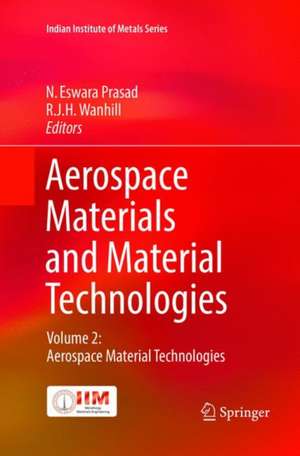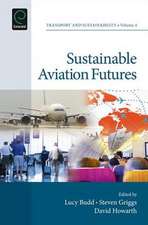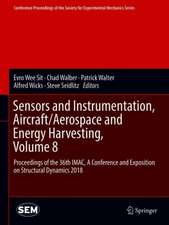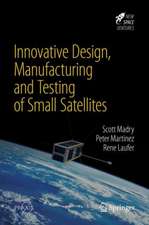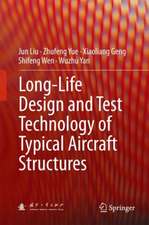Aerospace Materials and Material Technologies: Volume 2: Aerospace Material Technologies: Indian Institute of Metals Series
Editat de N. Eswara Prasad, R.J.H. Wanhillen Limba Engleză Paperback – 29 iun 2018
| Toate formatele și edițiile | Preț | Express |
|---|---|---|
| Paperback (1) | 1057.86 lei 39-44 zile | |
| Springer Nature Singapore – 29 iun 2018 | 1057.86 lei 39-44 zile | |
| Hardback (1) | 1085.73 lei 39-44 zile | |
| Springer Nature Singapore – 17 noi 2016 | 1085.73 lei 39-44 zile |
Din seria Indian Institute of Metals Series
- 18%
 Preț: 1410.63 lei
Preț: 1410.63 lei - 15%
 Preț: 650.69 lei
Preț: 650.69 lei - 18%
 Preț: 1839.17 lei
Preț: 1839.17 lei -
 Preț: 386.22 lei
Preț: 386.22 lei - 20%
 Preț: 551.06 lei
Preț: 551.06 lei - 18%
 Preț: 749.27 lei
Preț: 749.27 lei - 18%
 Preț: 1251.98 lei
Preț: 1251.98 lei - 18%
 Preț: 1245.97 lei
Preț: 1245.97 lei - 24%
 Preț: 1085.73 lei
Preț: 1085.73 lei - 24%
 Preț: 818.99 lei
Preț: 818.99 lei - 15%
 Preț: 656.43 lei
Preț: 656.43 lei - 20%
 Preț: 557.20 lei
Preț: 557.20 lei - 18%
 Preț: 975.22 lei
Preț: 975.22 lei - 18%
 Preț: 1023.74 lei
Preț: 1023.74 lei - 18%
 Preț: 1116.57 lei
Preț: 1116.57 lei - 18%
 Preț: 1116.57 lei
Preț: 1116.57 lei
Preț: 1057.86 lei
Preț vechi: 1391.92 lei
-24% Nou
Puncte Express: 1587
Preț estimativ în valută:
202.44€ • 211.09$ • 168.25£
202.44€ • 211.09$ • 168.25£
Carte tipărită la comandă
Livrare economică 17-22 martie
Preluare comenzi: 021 569.72.76
Specificații
ISBN-13: 9789811095405
ISBN-10: 981109540X
Pagini: 557
Ilustrații: XXVIII, 557 p. 283 illus., 172 illus. in color.
Dimensiuni: 155 x 235 mm
Ediția:Softcover reprint of the original 1st ed. 2017
Editura: Springer Nature Singapore
Colecția Springer
Seria Indian Institute of Metals Series
Locul publicării:Singapore, Singapore
ISBN-10: 981109540X
Pagini: 557
Ilustrații: XXVIII, 557 p. 283 illus., 172 illus. in color.
Dimensiuni: 155 x 235 mm
Ediția:Softcover reprint of the original 1st ed. 2017
Editura: Springer Nature Singapore
Colecția Springer
Seria Indian Institute of Metals Series
Locul publicării:Singapore, Singapore
Cuprins
Part – I: PROCESSING TECHNOLOGIES.- Chapter 1: Processing of Aerospace Metals & Alloys: Part A - Special Melting Technologies.- Chapter 2: Processing of Aerospace Metals & Alloys: Part B - Secondary Processing.- Chapter 3: Superplastic Forming of Aerospace Materials.- Chapter 4: Welding Technologies in Aerospace Applications.- Chapter 5: Nano Manufacturing for Aerospace Applications.- Part – II: CHARACTERISATION AND TESTING.- Chapter 6: Microstructure: An Introduction.- Chapter 7: Texture Effects in Important Aerospace Materials.- Chapter 8: Physical Property Significances for Aerospace Structural Materials. Chapter 9: Structural Alloy Testing: Part A – Ambient Temperature Properties.- Chapter 10: Structural Alloy Testing: Part B - Creep Deformation and Other High Temperature Properties.- Chapter 11: Non – Destructive Testing and Damage Detection.- Part – III: STRUCTURAL DESIGN.- Chapter 12: Design of Aircraft Structures: An Overview.- Chapter 13: Aircraft Mechanical Systems.- Chapter 14: Design and Structures of Aircraft Engines.- Chapter 15: Missile Propulsion Systems.- Chapter 16: Fatigue Requirements for Aircraft Structures.- Chapter 17: Full-Scale Fatigue Testing.- Chapter 18: Residual Strength Requirements for Aircraft Structures.- Chapter 19: Stress Corrosion Cracking in Aircraft Structures.- Part – IV: SPECIAL TECHNOLOGIES.- Chapter 20: Aero Stores (Materials) Inspection and Quality Assurance.- Chapter 21: Fatigue Life Enhancement for Metallic Airframe Materials.- Chapter 22: Structural Health Monitoring.- Chapter 23: Failure Analysis and Prevention.- Chapter 24: Airworthiness Certification of Metallic and Non-Metallic Materials: The Indian Approach and Methodologies.- Chapter 25: Lightweight Ballistic Armours for Aero Vehicle Protection.
Notă biografică
Dr. N. Eswara Prasad, FIE,FAPAS,FIIM, a B.Tech. (1985) and a Ph.D. (1993) in Metallurgical Engineering from Indian Institute of Technology (BHU), Varanasi, India, is an innovative and creative researcher and technologist. He is currently serving as Director, Defense Materials and Stores Research and Development Establishment (DMSRDE), DRDO at Kanpur, India.He has made significant and outstanding contributions to the Indian Defense Research and Development Organization (DRDO) in the last 30 years in the fields of design, materials development and characterization, and airworthiness certified production of many advanced aerospace, aeronautical and naval materials and components. The extensive research work conducted by him has resulted in the development and certified production of (i) Al & Al-Li alloys for LCA, LCH and Indian Space Programme, (ii) Aero Steels, including Maraging and PH Steels for Indian Missile Programmes, (iii) High strength and high temperature Ti Alloys, including -Ti alloys for LCA’s slat tracks and landing gear, (iv) Advanced Ultrahigh Temperature materials - Mo & Ti Intermetallics, Monolithic Ceramics (Structural Alumina, Graphite and SiC), Carbon, Silica and SiC based Continuous Fibre-reinforced, Ceramic-matrix Composites (CFCCs) for cutting edge components, systems and technologies. Application of these materials in DRDO has been complemented by him by extensive fundamental research on tensile deformation, fatigue and fracture, correlations between chemical composition-processing-microstructure-texture-deformation, leading to first time scientific explanations on Property Anisotropy. In the last 6 years, Dr. Prasad has been instrumental in the concurrent development and production of several airworthiness certified materials and components of Aero and Naval steels, Al alloys, Ni-base Superalloys, Ti sponge and Special Ti alloys for Indian Defense, Indian Air Force, Indian Navy and ATVP – the Indian Submarine Program, which have resulted in realizing defense hardware worth more than Rs. 12 billion, out of which direct materials production of nearly Rs. 6.2 Billions through 180 provisional clearances and 11 type approvals of CEMILAC. Dr. Prasad’s prolific research resulted over 170 research articles in peer-reviewed national and international journals and conference proceedings, including 30 written/edited books and book chapters as well as 26 classified and unclassified, as also peer reviewed technical reports and a highly acclaimed first International Monograph on Al-Li Alloys in 2014. He has also authored nearly 90 confidential reports and more than 260 certification documents for DRDO. In recognition of his original contributions in the fields of Metallurgy and Materials Engineering, Dr. Prasad had received several national and international awards. He has been the recipient of YOUNG SCIENTIST AWARD (ICSA, 1991), YOUNG METALLURGIST (Ministry of Steel,1994), AvH’s Humboldt Research Fellowship (1998-99), Max-Planck-Institute (Stuttgart)’s Visiting Scientist (1998-99), Binani Gold Medal (IIM, 2006), METALLURGIST OF THE YEAR (Ministry of Steel, 2010), AICTE-INAE Distinguished Visiting Professorship at Andhra University and Mahatma Gandhi Institute of Technology (INAE, 2012-Till Date), IIT-BHU(MET)’s Distinguished Alumnus Award (2013) and the prestigious Dr. VM Ghatge Award of AeSI (in 2014).Dr. Prasad is a Fellow of Institute of Engineers (India) [FIE], Indian Institute of Metals [FIIM] and AP Akademi of Sciences [FAPAS].
Dr. R. J. H. Wanhill is emeritus Principal Research Scientist at the Netherlands Aerospace Centre, formerly the National Aerospace Laboratory NLR, in the Netherlands. He holds two Doctorates, one from the University of Manchester (1968) and the second from the Delft University of Technology (1994). He joined the NLR in 1970, and since then has investigated fatigue and fracture of all classes of aerospace alloys. He is co-author of the book ‘Fracture Mechanics’ (1984), which has run into a second edition; co-author with Simon Barter of the monograph ‘Fatigue of Beta Processed and Beta Heat-treated Titanium Alloys’, published by Springer in 2012; and co-author and co-editor for the book ‘Aluminium - Lithium Alloys: Processing, Properties and Applications’, editors N. Eswara Prasad, Amol A. Gokhale and R. J. H. Wanhill, published in 2014.From 1978 to 1996 Dr. Wanhill was head of the Materials Department of the NLR, and in 1979-80 adjunct professor of materials at Delft University of Technology. From 1997 to 2008 he was a Principal Research Scientist in the Aerospace Vehicles Division of the NLR. From 2008 to 2015 he has been emeritus Principal Research Scientist at the NLR. In 2002 the Board of the Foundation NLR awarded Dr. Wanhill the first Dr.ir.B.M. Spee Prize for outstanding contributions on aerospace materials. In October 2014 he was awarded an Honour Diploma by the Netherlands Aerospace Fund for his long-term contributions to scientific research and knowledge at the NLR, and use of this knowledge for aircraft failure analyses. In recent years Dr. Wanhill has worked on the analysis of fatigue cracking in GLARE panels from the Airbus 380 MegaLiner Barrel test (presented at ICAF 2009) and, in collaboration with Dr. Simon Barter (Defence Science and Technology Group, DSTG, Melbourne). From November 2009 to May 2010 Dr. Wanhill was a Visiting Academic at the DSTG. The work there included (i) a collaborative report, book chapter, and presentation for the Royal Australian Air Force (RAAF) on fatigue life assessment of combat aircraft; (ii) a book chapter on stress corrosion cracking (SCC) in aerospace; (iii) two seminar presentations, on service failures and the MegaLiner Barrel GLARE cracking (see above); and (iv) preparation of a course on failure analysis, held twice at Auckland Technical University at the beginning of May 2010. This course has been adopted by the RAAF as part of its instructionmaterial. Since 1994 Dr. Wanhill has been investigating fracture phenomena in ancient silver and iron, and has published eight peer-reviewed papers on this topic. The most recent papers have been published in the Journal of Failure Analysis and Prevention (2011), Metallography, Microstructure, and Analysis (2012) and the leading archaeological scientific journal Studies in Conservation (2013). Dr. Wanhill also gives annual lectures on ancient silver for a Master’s Degree course on conservation at the University of Amsterdam. Dr. Wanhill has been an author and speaker on several fatigue and fracture topics and also on fatigue-based design of aircraft structures. In 2012, Dr. Wanhill was a keynote speaker for the International Conference on Engineering Failure Analysis V, held in The Hague. He also had two additional contributions, with co-authors: “Validation of F-16 wing attachment fitting bolts” and “Five helicopter accidents with evidence of material and/or design deficiencies”. Allthree presentations have been published as papers in Engineering Failure Analysis in 2013. In 2014 he was a keynote speaker at Fatigue 2014, held in Melbourne. In 2015 he gave a Public Lecture at Materials Days 2015, Rostock, with the title “Materials and structural integrity: Milestone aircraft case histories and continuing developments”. This presentation has also been adopted by the RAAF as instruction material, and in written chapter form will be published in ‘The Reference Module in Materials Science and Engineering’.
Dr. R. J. H. Wanhill is emeritus Principal Research Scientist at the Netherlands Aerospace Centre, formerly the National Aerospace Laboratory NLR, in the Netherlands. He holds two Doctorates, one from the University of Manchester (1968) and the second from the Delft University of Technology (1994). He joined the NLR in 1970, and since then has investigated fatigue and fracture of all classes of aerospace alloys. He is co-author of the book ‘Fracture Mechanics’ (1984), which has run into a second edition; co-author with Simon Barter of the monograph ‘Fatigue of Beta Processed and Beta Heat-treated Titanium Alloys’, published by Springer in 2012; and co-author and co-editor for the book ‘Aluminium - Lithium Alloys: Processing, Properties and Applications’, editors N. Eswara Prasad, Amol A. Gokhale and R. J. H. Wanhill, published in 2014.From 1978 to 1996 Dr. Wanhill was head of the Materials Department of the NLR, and in 1979-80 adjunct professor of materials at Delft University of Technology. From 1997 to 2008 he was a Principal Research Scientist in the Aerospace Vehicles Division of the NLR. From 2008 to 2015 he has been emeritus Principal Research Scientist at the NLR. In 2002 the Board of the Foundation NLR awarded Dr. Wanhill the first Dr.ir.B.M. Spee Prize for outstanding contributions on aerospace materials. In October 2014 he was awarded an Honour Diploma by the Netherlands Aerospace Fund for his long-term contributions to scientific research and knowledge at the NLR, and use of this knowledge for aircraft failure analyses. In recent years Dr. Wanhill has worked on the analysis of fatigue cracking in GLARE panels from the Airbus 380 MegaLiner Barrel test (presented at ICAF 2009) and, in collaboration with Dr. Simon Barter (Defence Science and Technology Group, DSTG, Melbourne). From November 2009 to May 2010 Dr. Wanhill was a Visiting Academic at the DSTG. The work there included (i) a collaborative report, book chapter, and presentation for the Royal Australian Air Force (RAAF) on fatigue life assessment of combat aircraft; (ii) a book chapter on stress corrosion cracking (SCC) in aerospace; (iii) two seminar presentations, on service failures and the MegaLiner Barrel GLARE cracking (see above); and (iv) preparation of a course on failure analysis, held twice at Auckland Technical University at the beginning of May 2010. This course has been adopted by the RAAF as part of its instructionmaterial. Since 1994 Dr. Wanhill has been investigating fracture phenomena in ancient silver and iron, and has published eight peer-reviewed papers on this topic. The most recent papers have been published in the Journal of Failure Analysis and Prevention (2011), Metallography, Microstructure, and Analysis (2012) and the leading archaeological scientific journal Studies in Conservation (2013). Dr. Wanhill also gives annual lectures on ancient silver for a Master’s Degree course on conservation at the University of Amsterdam. Dr. Wanhill has been an author and speaker on several fatigue and fracture topics and also on fatigue-based design of aircraft structures. In 2012, Dr. Wanhill was a keynote speaker for the International Conference on Engineering Failure Analysis V, held in The Hague. He also had two additional contributions, with co-authors: “Validation of F-16 wing attachment fitting bolts” and “Five helicopter accidents with evidence of material and/or design deficiencies”. Allthree presentations have been published as papers in Engineering Failure Analysis in 2013. In 2014 he was a keynote speaker at Fatigue 2014, held in Melbourne. In 2015 he gave a Public Lecture at Materials Days 2015, Rostock, with the title “Materials and structural integrity: Milestone aircraft case histories and continuing developments”. This presentation has also been adopted by the RAAF as instruction material, and in written chapter form will be published in ‘The Reference Module in Materials Science and Engineering’.
Textul de pe ultima copertă
This book serves as a comprehensive resource on various traditional, advanced and futuristic material technologies for aerospace applications encompassing nearly 20 major areas. Each of the chapters addresses scientific principles behind processing and production, production details, equipment and facilities for industrial production, and finally aerospace application areas of these material technologies. The chapters are authored by pioneers of industrial aerospace material technologies. This book has a well-planned layout in 4 parts. The first part deals with primary metal and material processing, including nano manufacturing. The second part deals with materials characterization and testing methodologies and technologies. The third part addresses structural design. Finally, several advanced material technologies are covered in the fourth part. Some key advanced topics such as “Structural Design by ASIP”, “Damage Mechanics-Based Life Prediction and Extension” and “Principles of Structural Health Monitoring” are dealt with at equal length as the traditional aerospace materials technology topics. This book will be useful to students, researchers and professionals working in the domain of aerospace materials.
Caracteristici
Provides brief overviews of all important aerospace materials and materials technologies, without exception Serves as a comprehensive ready reference Presents an application-oriented treatment of materials technologies Includes supplementary material: sn.pub/extras
